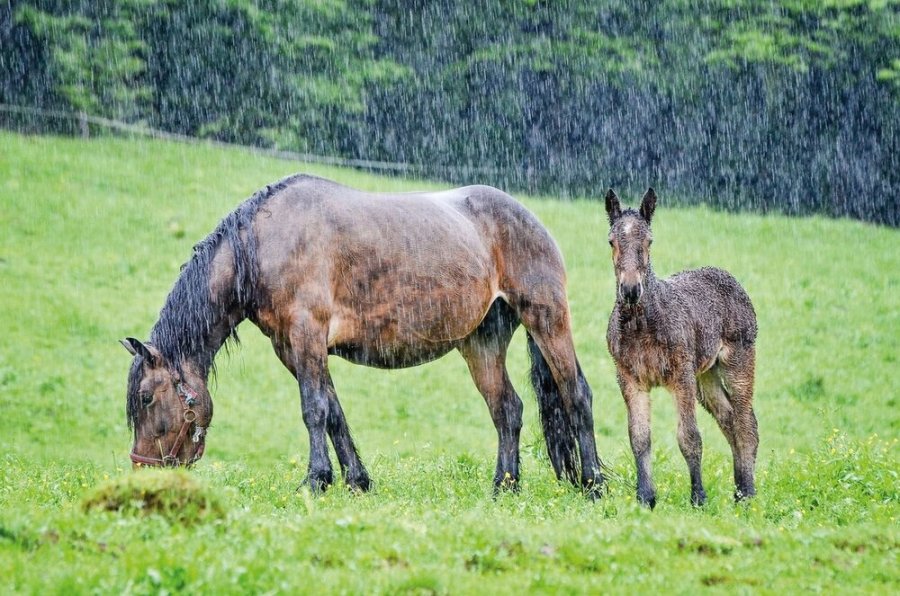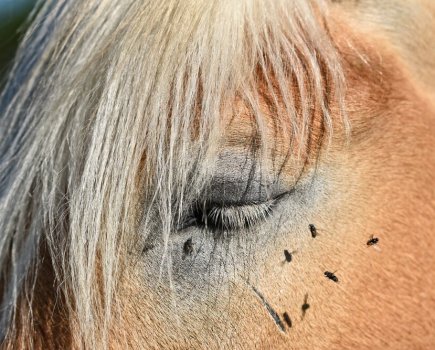The first thing most of us do when it starts to rain is put on a waterproof coat, but unlike people, horses are designed to get wet and so it isn’t always necessary for them to wear a rug when the heavens open.
Small horse breeds such as the Shetland have evolved with a coat that is almost waterproof without any help from a rug. Even on very wet days, if you part the coat of one of these hardy ponies while they are wintering outdoors you will find the skin is virtually dry — and warm.
These breeds have a dense, soft, insulating underlayer which traps air between the hairs. This inner layer is overlaid with an outer layer of longer hairs.
These latter hairs have an oily coating secreted by sebaceous glands that open into the hair follicles. This water-repelling oil is continuously secreted onto the hairs at a low level.
If the horse rolls (and this may be one reason why horses do it), contact with the ground compresses the follicles causing more oil to be squeezed onto the hair.
The traditional practice of strapping — banging a horse’s skin with a wisp of hay or straw — results in a shiny coat because oil is squeezed from the glands onto the hair. Shampooing removes this oily layer, significantly reducing the horse’s natural weatherproofing.
Shivering for heat
We should also remember that the horse’s digestive system plays an important role in keeping them warm. On cold days, horses keep their core body temperature warm by reducing the blood supply to the extremities.
Their ears and legs become cold, and the hairs in the skin become more erect, increasing the depth of the insulating layer of air close to the skin.
Once the air temperature drops below 0ºC (known as the lower critical temperature or LCT), the horse increases their metabolic rate to generate heat and, in extreme cases, starts shivering.
Shivering is a reflex action triggered by an area in the brain that is stimulated by cold skin. The shivering muscles generate heat as a by-product of their contractions.
The response of horses to rain seems to be highly individual. Some will immediately seek cover under trees or in afield shelter while others seem unmoved and continue grazing.
But when rain is very heavy or accompanied by strong winds, most horses will try to find some protection — for example, by standing against a fence or a tree line.
You will find that they do this even when the horse is wearing a rug.
Tail to the wind
The horse’s rear end will be directed towards the wind, ensuring only the smallest area of their body is exposed when they are not wearing a rug.
The tail and dock protect the hairless areas underneath. When rain lands on the horse the outer hairs collapse and bunch together in a downward direction.
This deflects and channels the water off the horse, while protecting the inner layer from getting wet. The collapse of the outer coat causes less air to be trapped in the deeper layer, increasing heat loss.
When the rain stops, the wet hairs dry as the moisture evaporates. This process is assisted by the horse’s movement and by wind travelling across the coat.
Just as with sweating during exercise, the evaporating moisture takes heat with it, cooling — and in some cases chilling — the horse.
Also, unless the horse is groomed, the segmentation of the hair into bunches persists for several days after drying, prolonging the cooling effect.
Finer horse breeds
In contrast to native ponies, the soft inner layer in finer-coated breeds is shallower and the outer layer of hair is shorter.
As well as an overall reduced insulating effect, there is less resistance to the chilling impact of rain on the skin.
Rapid evaporation of water from a wet coat caused by wind may result in wind chill. This can be quite marked in some horse breeds, such as Thoroughbreds, who often will benefit from wearing a waterproof rug.
While rain scald and mud fever have long been associated with constant wetting of the coat and legs, we also have to consider how a wet coat can affect the horse’s ability to regulate body temperature and develop strategies to mitigate any adverse effects.
Given an opportunity to adapt, horses are far more tolerant of cold weather than humans are. In fact, horses are more likely to be stressed by heat than by cold and so it may not be in their interest to reach for that rug you’ve been eyeing up.
Resisting the cold
We often underestimate how cold-resistant horses are. A person’s lower critical temperature (unclothed) is 25ºC, well in excess of that of horses.
On cold days, if we feel cold, our horses probably do not.
However, when we add in rain and wind, a significant chilling effect may occur. Both young and veteran horses have been shown to be less tolerant of cold and need extra care.
Young horses have less body fat to insulate them. Older horses are less well able to regulate their body temperature, are generally less active, have a less efficient digestive system and sometimes have health problems.
In all of these cases, wearing a good quality and well-fitting waterproof rug will be useful.
Main image © Shutterstock









